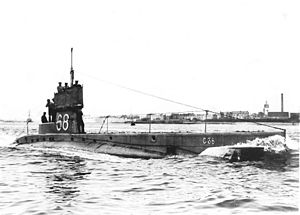This is the current revision of this page, as edited by Frietjes (talk | contribs) at 21:25, 15 October 2024 (update template syntax). The present address (URL) is a permanent link to this version.
Revision as of 21:25, 15 October 2024 by Frietjes (talk | contribs) (update template syntax)(diff) ← Previous revision | Latest revision (diff) | Newer revision → (diff) C-class submarine built for the Royal Navy
 HMS C38 – a typical C-class submarine HMS C38 – a typical C-class submarine
| |
| History | |
|---|---|
| Name | HMS C11 |
| Builder | Vickers, Barrow |
| Laid down | 6 April 1906 |
| Launched | 27 March 1907 |
| Commissioned | 3 September 1907 |
| Fate | Sunk in collision 14 July 1909 |
| General characteristics | |
| Class and type | C-class submarine |
| Displacement |
|
| Length | 142 ft 3 in (43.4 m) |
| Beam | 13 ft 7 in (4.1 m) |
| Draught | 11 ft 6 in (3.5 m) |
| Installed power |
|
| Propulsion |
|
| Speed |
|
| Range | 910 nmi (1,690 km; 1,050 mi) at 12 kn (22 km/h; 14 mph) on the surface |
| Test depth | 100 feet (30.5 m) |
| Complement | 2 officers and 14 ratings |
| Armament | 2 × 18 in (450 mm) bow torpedo tubes |
HMS C11 was one of 38 C-class submarines built for the Royal Navy in the first decade of the 20th century. The boat was lost after being rammed in 1909.
Design and description
The C class was essentially a repeat of the preceding B class, albeit with better performance underwater. The submarine had a length of 142 feet 3 inches (43.4 m) overall, a beam of 13 feet 7 inches (4.1 m) and a mean draft of 11 feet 6 inches (3.5 m). They displaced 287 long tons (292 t) on the surface and 316 long tons (321 t) submerged. The C-class submarines had a crew of two officers and fourteen ratings.
For surface running, the boats were powered by a single 16-cylinder 600-brake-horsepower (447 kW) Vickers petrol engine that drove one propeller shaft. When submerged the propeller was driven by a 300-horsepower (224 kW) electric motor. They could reach 12 knots (22 km/h; 14 mph) on the surface and 7 knots (13 km/h; 8.1 mph) underwater. On the surface, the C class had a range of 910 nautical miles (1,690 km; 1,050 mi) at 12 knots (22 km/h; 14 mph).
The boats were armed with two 18-inch (45 cm) torpedo tubes in the bow. They could carry a pair of reload torpedoes, but generally did not as they would have to remove an equal weight of fuel in compensation.
Construction and career
C11 was built by Vickers at their Barrow-in-Furness shipyard, laid down on 6 April 1906 and was commissioned on 3 September 1907. The boat was sunk in a collision with the collier Eddystone in the North Sea south of Cromer, Norfolk on 14 July 1909. There were only three survivors. Attempts were made to salvage the stricken submarine but they were abandoned in September 1909, after only a single body had been recovered. The wreck was rediscovered in the late 1990s.
Notes
- ^ Gardiner & Gray, p. 87
- Harrison, Chapter 3
- Harrison, Chapter 27
- ^ Gray, Edwyn (2003). Disasters of the Deep A Comprehensive Survey of Submarine Accidents & Disasters. Leo Cooper. p. 64. ISBN 0-85052-987-5.
- "Naval Matters—Past and Prospective: Sheerness Dockyard". The Marine Engineer and Naval Architect. Vol. 32. October 1909. p. 98.
References
- Akermann, Paul (2002). Encyclopaedia of British Submarines 1901–1955 (reprint of the 1989 ed.). Penzance, Cornwall: Periscope Publishing. ISBN 1-904381-05-7.
- Colledge, J. J.; Warlow, Ben (2006) . Ships of the Royal Navy: The Complete Record of all Fighting Ships of the Royal Navy (Rev. ed.). London: Chatham Publishing. ISBN 978-1-86176-281-8.
- Gardiner, Robert & Gray, Randal, eds. (1985). Conway's All the World's Fighting Ships 1906–1921. Annapolis, Maryland: Naval Institute Press. ISBN 0-85177-245-5.
- Harrison, A. N. (January 1979). "The Development of HM Submarines From Holland No. 1 (1901) to Porpoise (1930) (BR3043)". RN Subs. Retrieved 27 September 2022.
External links
- HMS C11 Roll of Honour
- 'Submarine losses 1904 to present day' – Royal Navy Submarine Museum Archived 7 January 2018 at the Wayback Machine
| British C-class submarines | |
|---|---|
| Shipwrecks and maritime incidents in 1909 | |
|---|---|
| Shipwrecks |
|
| Other incidents |
|
| 1908 | |
Categories: